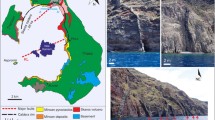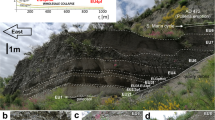Abstract
An elastic point source model proposed by Mogi for magma chamber inflation and deflation has been applied to geodetic data collected at many volcanoes. The volume of ground surface uplift or subsidence estimated from this model is closely related to the volume of magma injection into or withdrawal from the reservoir below. The analytical expressions for these volumes are reviewed for a spherical chamber and it is shown that they differ by the factor 2(1-v), where v is Poisson's ratio of the host rock. For the common estimate v=0.25, as used by Mogi and subsequent workers, the uplift volume is 3/2 the injection volume. For highly fractured rocks, v can be even less and the uplift volume can approach twice the injection volume. Unfortunately, there is no single relation between the inflation of magma reservoirs and the dilation or contraction of host rocks. The inflation of sill-like bodies, for instance, generates no overall change in host rock volume. Inflation of dike-like bodies generates contraction such that, in contrast with Mogi's result, the uplift volume is generally less than the injection volume; for v=0.25, the former is only 3/4 of the latter. Estimates of volumes of magma injection or withdrawal are there-fore greatly dependent on the magma reservoir configuration. Ground surface tilt data collected during the 1960 collapse of Kilauea crater, one of the first events interpreted with Mogi's model and one of the largest collapses measured at Kilauea, is not favored by any one of a variety of deformation models. These models, however, predict substantially different volumes of both magma withdrawal and ground surface subsidence.
Similar content being viewed by others
References
Davis PM, Hastie LM, Stacey FD (1974) Stresses within an active volcano-with particular reference to Kilauea. Tectonophysics 22:355–362
Delaney PT, Miklius A, Arnadottir T, Okamura AT, Sako MK (1993) Motion of Kilauea volcano during sustained eruption from the Puu Oo and Kupaianaha vents, 1983–1991. J Geophys Res 98:17801–17820
Delaney PT, Miklius A, Arnadottir T, Okamura AT, Sako MK (1994) Motion of Kilauea volcano during sustained eruption from the Puu Oo and Kupaianaha vents, 1983–1991: supplemental information. US Geol Surv Open File Rep 94-567
Dieterich JH, Decker RW (1975) Finite element modeling of surface deformation associated with volcanism. J Geophys Res 80:4094–4102
Dvorak JJ, Dzurisin D (1993) Variations in magma supply rate at Kilauea Volcano Hawaii. J Geophys Res 98:22255–22268
Dvorak JJ, Okamura AT, Dieterich JH (1983) Analysis of surface deformation data Kilauea Volcano, Hawaii: October 1966 to September 1970. J Geophys Res 88:9295–9304
Dzurisin D, Anderson LA, Eaton GP, Koyanagi RY, Lipman PW, Lockwood JP, Okamura RT, Puniwai GS, Sako MK, Yamashita KM (1980) Geophysical observations of Kilauea volcano, Hawaii, 2. Constraints on the magma supply during November 1975-September 1977. J Volcanol Geotherm Res 7:241–269
Eaton JP (1962) Crustal structure and volcanism in Hawaii. Am Geophys Union Geophys Monogr 6:13–29
Jackson DB, Swanson DA, Koyanagi RY, Wright TL (1975) The August and October 1968 east rift eruptions of Kilauea Volcano, Hawaii. US Geol Surv Prof Pap 890
Klein FW (1978) Hypocenter location program HYPOIN-VERSE. US Geol Surv Open File Rep 78-694
Klein FW (1981) A linear gradient crustal model for south Hawaii. Bull Seism Soc Am 71:1503–1510
McTigue DF (1987) Elastic stress and deformation near a finite spherical magma body: resolution of the point source paradox. J Geophys Res 92:12931–12940
Mogi K (1958) Relations between the eruptions of various volcanoes and the deformations of the ground surfaces around them. Bull Earthquake Res Inst, Univ Tokyo 36:99–134
Okada Y (1985) Surface deformation due to shear and tensile faults in a half-space. Bull Seism Soc Am 75:1135–1154
Okamura AT (1988) Water-tube and spirit-level tilt data, Hawaiian Volcano Observatory 1958–1986. US Geol Survey Open File Rep 88-237
Rundle JB, Whitcomb JH (1984) A model for deformation in Long Valley, California, 1980–1983. J Geophys Res 89:9371–9380
Ryan MP, Blevins JYK, Okamura AT, Koyanagi RY (1983) Magma reservoir mechanics: theoretical summary and application to Kilauea Volcano. J Geophys Res 88:4147–4182
Savage JC, Clark MM (1982) Magmatic resurgence in Long Valley caldera, California: possible cause of the 1980 Mammoth Lakes earthquakes. Science 217:531–533
Savage JC, Prescott WH, Chamberlain JF, Lisowski M, Mortensen CE (1979) Geodetic tilt measurements along the San Andreas fault in central California. Bull Seism Soc Am 69:1965–1981
Touloukian YS, Judd WR, Roy RF (1981) Physical Properties of Rocks and Minerals. McGraw-Hill, New York, 548 pp
Yang X, Davis PM, Delaney PT, Okamura AT (1992) Geodetic analysis of dike intrusion and motion of the magma reservoir beneath the summit of Kilauea Volcano, Hawaii: 1970–1985. J Geophys Res 97:3305–3324
Author information
Authors and Affiliations
Corresponding author
Rights and permissions
About this article
Cite this article
Delaney, P.T., McTigue, D.F. Volume of magma accumulation or withdrawal estimated from surface uplift or subsidence, with application to the 1960 collapse of Kilauea volcano. Bull Volcanol 56, 417–424 (1994). https://doi.org/10.1007/BF00302823
Received:
Accepted:
Issue Date:
DOI: https://doi.org/10.1007/BF00302823




